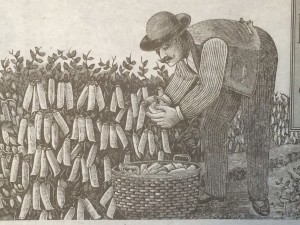SAVING VEGETABLE SEEDS FROM YOUR GARDEN
SEED SAVING
An excellent way to preserve a favorite vegetable variety is to harvest and save the seed from your own garden plants. This can be done with all open-pollinated (non-hybrid) vegetables. Hybrids are pollinated by humans for a specific resulting plant. (Seeds saved from hybrids will not produce the same fruit or vegetable you grew.) Many rare, open-pollinated heirloom vegetables and flowers have been saved and passed down for generations. Some Native American kinds of squash, corn, beans and sunflowers have been passed down by various tribes for over a thousand years! Several heirloom kinds of lettuce, peppers, pumpkins, squash, tomatoes and other vegetables still exist from Colonial and Victorian times.
Locally adapted varieties will be the most successful and productive. You will need to save about 100 to 150 seeds of each cultivar you want to save. Some easy vegetables to begin with are tomatoes, beans, peas, and lettuce, which are all self-pollinating and easier to keep true to type; they can also be cross-pollinated. Other vegetables need to be cross-pollinated to produce seed and will cross with other nearby plants of the same genus or species. Each variety needs to be isolated so it will remain true to type.
Isolation may be accomplished by distance; staggering maturity dates; by caging, or bagging. For most vegetables 200 feet of distance is enough to retain genetic purity, but some, such as corn, need a mile or more. Staggering maturity might be accomplished by planting two strains of corn, one maturing at 65 days and another at 80-85 days. Pollination of the early variety will be finished by the time the later one is ready to pollinate. Cages can be built and covered with row cover fabric to isolate radishes, beets, turnips, carrots, parsnips and onions. A bait of honey spread upon a plate will attract bees into an uncovered cage. When about 15 bees are present, cover the cage for an hour or two; release the bees before sunset. There are three species of squashes and pumpkins commonly grown so you must research this if you want to keep your strain pure. Corn, squash and pumpkins can be hand-pollinated if bagged.
In the garden, give plants grown for seed more space to accommodate tall seed stalks. Select the most healthy, robust plants to save seed from. The fruit should be riper than that used for eating. Usually fruit will turn yellow, soften and sometimes even begin to rot before seeds are mature. Pea seed turns green or yellow; beets, beans and watermelon seeds darken; peppers and squash seeds are usually white, and corn seed (especially sweet corn) will dent and shrivel.
To process seed for storage, remove pulp, juice or flesh and dry the seeds on a fine screen because seeds will stick to paper or cloth. A float test will show viable seeds. Those that float will not grow. Dry the seeds to about 10% moisture before storing away in glass jars with metal lids. Glass jars are the best way to keep out humidity, which might cause your seeds to sprout and die in storage. A cool, dry place is best for storage, or you may place the jars in the refrigerator. Label your seeds carefully to keep good records.

